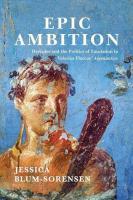
Wisconsin (2023) h/b 327pp £99.95 (ISBN 9780299344603)
The Argonautica of Valerius Flaccus (henceforward V.), which loosely follows the better-known work of Apollonius Rhodius (c. 200 BC), is in 8 books, of which, however, the last breaks off perhaps 300 lines before its likely ending. The reason for this is not known, but some inconsistencies in the text argue (perhaps) that V. had died before he could complete and correct his work; his recent death is in fact alluded to by Quintilian. The epic was composed, c. AD 70-96, under the principates of the Flavians, from Vespasian to Domitian (Flavia gens, quantum tibi tertius abstulit heres! Paene fuit tanti non habuisse duos [Martial], not cited by B-S). It may be helpful to observe that the most accessible text is that of the elderly Loeb Library edition by J. H. Mozley (1936), which also has a brief Introduction. (Those interested in textual matters may like to note that at one point where Mozley prints an emendation by N. Heinsius [Argonautica 3. 515], A.E. Housman argued for retention of the MS reading: Classical Papers, vol III, p.1075).
B-S is addressing herself to weightier matters. To what extent may the actions of the Argonauts bring to men’s minds the heroic deeds of the Romans in earlier times? Could they be an example for great deeds yet to be carried out? Rather unexpectedly, B-S lays considerable stress on Hercules—an Argonaut who, at 1.621 ff, finds himself in a storm with his companions—and is no better equipped than anyone else, for all his strength and divine birth, to face the challenges of the sea. V. was writing in the aftermath of AD 69, the year of the four emperors, and this cannot but have left its mark—as doubtless also on T. Stover’s Epic and Empire in Vespasianic Rome (2012). B-S goes on to show that while the Argonauts display their martial qualities, they are also seeking future glory: but whether, as B-S argues, that there are ‘mutual and self-reinforcing desires on the parts of actors, audience, and poet to read their mythological or historical narrative through a particular lens that creates a particular, generically encoded teleology’ (a word very frequently employed by B-S) is perhaps less obvious.
B-S argues that Rome’s outward expansion raised the disquieting possibility of civil strife: for, following in the footstep of Hercules, the Argonauts’ outward voyage ‘brings them ever closer to self-destructive violence motivated by emulative virtus’. V., says B-S, offers a new teleology of epic exemplarity. The arguments are worked out in much greater detail as the book proceeds. It may help to give an example from Chapter 6 (‘Through the Looking Glass’): ‘Jason and his companions continually confront a disjuncture between the pressure exerted by a Romanized ethos of imitatio and the realities of their changing world’. The end point is Colchis, ‘where the Argonautic tradition’s competing teleologies come to fruition in preview or reality’.
Later, B-S uses Virgilian markers to foreshadow the consequences of Medea’s madness. Indeed, there is a multiplication of Virgilian intertexts: in his Teubner edition of 1875, E. Baehrens had six pages of references to ‘Loci Vergiliani’. By reading exemplary actions from a different generic standpoint, Juno ‘renarrativises her actors towards a different teleology’, ‘repurposing the epic tradition toward a wider history of international conflict’. It is difficult to sum up the multiple threads of B-S’s argumentation: for B-S, however, V. writes the script for his new Flavian age, a ‘mythological ekphrasis that shows his audience exactly (B-S’s italics) what they need to know about the multiple teleologies already awaiting them in the future’.
And yet: as the readers took in the narrative of V.’s epic poem, how keenly attuned were they really to the prospects for the empire under the Flavians? Vespasian himself, as we read in Suetonius, mocked some attempts by his supporters to exalt the Flavians’ humble origins by linking them to Hercules, whereas Vespasian and Titus, by their ostentatious espousal of Augustan values, ‘performed a sort of ideological pietas’. The book’s text—250 pages, often including lengthy quotations (always translated)—can be, at times, of daunting density (the reviewer noticed the relative frequency with which B-S introduces a new paragraph with the word ‘then’, implying that the preceding argument was definitive). It may be that B-S asks more of the readers, whether those of today or those of c. AD 90, than V.’s text provides; what is certain is that worthwhile questions have been raised, e.g. has V. ‘succeeded in rerouting the Argonauts’ collective epic toward different narrative teleologies?’ (In this context, page 213 should be read in its entirety.) In sum, B-S is to be congratulated on demonstrating that there is much more to V`s Argonautica than the mere repetition of a hackneyed theme.
The text is followed by 40 pages of useful end-notes and a modest (by today’s standards) bibliography of about 20 pages; the reviewer noted 14 articles by A. Zissos, including one on ‘Reception of V.F.’s Argonautica’. The Index locorum has only nine references to Apollonius Rhodius against over 100 for Virgil. There is also a general Index.
Both the (rather overlooked) poem and, therefore, this detailed study demand to be read attentively, and it must be accepted that the readership of both is likely to be limited and specialist, not helped by the lofty cost. The Loeb translation, too, though revised in 1989, is surely due for replacement.
Colin Leach
